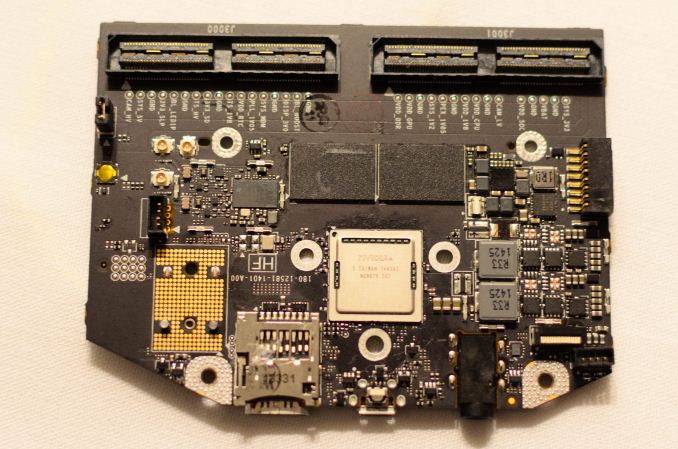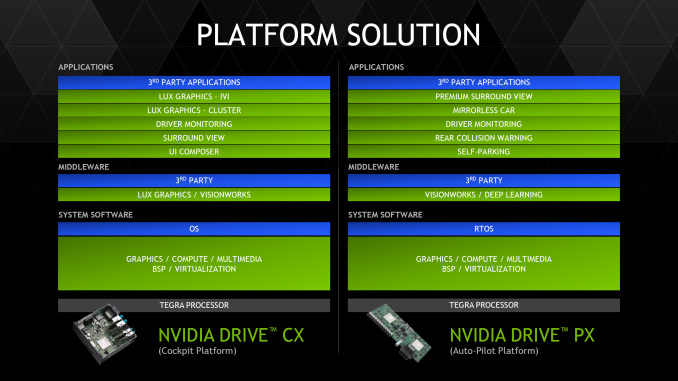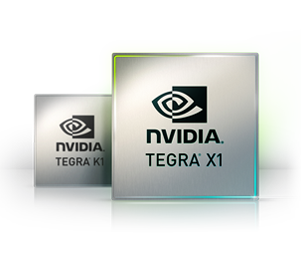NVIDIA Tegra X1 Preview & Architecture Analysis
by Joshua Ho & Ryan Smith on January 5, 2015 1:00 AM EST- Posted in
- SoCs
- Arm
- Project Denver
- Mobile
- 20nm
- GPUs
- Tablets
- NVIDIA
- Cortex A57
- Tegra X1
Final Words
With the Tegra X1, there have been a great deal of changes when compared to Tegra K1. We see a move from Cortex A15 to A57 on the main cluster, and a move from a single low power Cortex A15 to four Cortex A53s which is a significant departure from previous Tegra SoCs. However, the CPU design remains distinct from what we see in SoCs like the Exynos 5433, as NVIDIA uses a custom CPU interconnect and cluster migration instead of ARM’s CCI-400 and global task scheduling. Outside of these CPU changes, NVIDIA has done a great deal of work on the uncore, with a much faster ISP and support for new codecs at high resolution and frame rate, along with an improved memory interface and improved display output.
Outside of CPU, the GPU is a massive improvement with the move to Maxwell. The addition of double-speed FP16 support for the Tegra X1 helps to improve performance and power efficiency in applications that will utilize FP16, and in general the mobile-first focus on the architecture makes for a 2x improvement in performance per watt. While Tegra K1 set a new bar for mobile graphics for other SoC designers to target, Tegra X1 manages to raise the bar again in a big way. Given the standards support of Tegra X1, it wouldn’t be a far leap to see more extensive porting of games to a version of SHIELD Tablet with Tegra X1.
NVIDIA has also made automotive applications a huge focus in Tegra X1 in the form of DRIVE CX, a cockpit computing platform, and DRIVE PX, an autopilot platform. Given the level of integration and compute present in both DRIVE CX and PX, there seems to be a significant amount of value in NVIDIA’s solutions. However, it remains to be seen whether OEMs will widely adopt these solutions as car manufacturers can take multiple years to implement a new SoC. Compared to the 3-4 month adoption rate of an SoC in a phone or tablet, it's hard to pass any judgment on whether or not NVIDIA's automotive endeavors will be a success.
Overall, Tegra X1 represents a solid improvement over Tegra K1, and now that NVIDIA has shifted their GPU architectures to be targeted at mobile first, we’re seeing the benefits that come with such a strategy. It seems obvious that this would be a great SoC to put in a gaming tablet and a variety of other mobile devices, but it remains to be seen whether NVIDIA can get the design wins necessary to make this happen. Given that all of the high-end SoCs in the Android space will be shipping with A57 and A53 CPUs, the high-end SoC space will see significant competition once again.













194 Comments
View All Comments
Yojimbo - Monday, January 5, 2015 - link
I can imagine that NVIDIA might release a Denver-and-updated-Maxwell-powered SOC in 2016 and if Denver is successful then a Pascal-and-Denver-powered SOC in 2017. ??? Unless NVIDIA is able to improve their execution well enough to release a Pascal-powered SOC in time for next year. That last possibility seems a bit far-fetched considering their history in the segment, though.jjj - Monday, January 5, 2015 - link
Actually the high end SoC market won't be competitive since only Qualcomm has integrated modem.Guess 4 Denver cores was not doable on 20nm (die size or clocks) and that's disappointing, was really looking forward to more big cores. If they can get the CPU perf they claim, it's not bad but they might have a small window before 16nm shows up.
Seems another lost year in mobile for Nvidia, if they even care about it anymore, not so sure they do.
A quad Denver in high end, a dual for midrange and glasses, ofc both with integrated modem and maybe they would have been relevant again.
Krysto - Monday, January 5, 2015 - link
Strange that Nvidia still hasn't made big strides with its "soft-modem" that was supposed to easily support multiple bands at once.Yojimbo - Monday, January 5, 2015 - link
The soft-modem thing didn't seem to work out the way they had hoped. They seem to have given up trying to compete with Qualcomm in the smartphone market. The OEMs don't like the soft-modem and don't Iike a separate modem chip. NVIDIA's SOCs just don't differentiate themselves significantly enough from Qualcomm's that the OEMs are willing to accept one of those two things. Plus Samsung controls most of the Android smartphone market and seems to be very comfortable with their supplier system. I bet frustration about that on the part of NVIDIA is probably partially what led to the patent lawsuit. In any case, I wonder what NVIDIA is doing with Icera currently... if they are trying to sell it, or what.PC Perv - Monday, January 5, 2015 - link
Not that I think Denver is great or terrible or anything, but modems are not very important on tablets because number of 4G tablets are a fraction of WiFi ones.darkich - Monday, January 5, 2015 - link
Do you people finally see now just how PATHETIC Intel Core M is??Its top of the line chip, done on way superior process, costs $270, has a GPU that manages around 300GFLOPS, while this here 20nm chip that will sell for well under $100, reaches over 1 TERAFLOP!!
And the yearly doubling of the mobile GPU power continues.
Seems like in 2016 we could see small tablets that will be graphically more capable than Xbox one
Krysto - Monday, January 5, 2015 - link
No disagreement there. Broadwell is a dud (weak update to Haswell) and Broadwel-Y/Core M is a scam that will trick users into buying low-performance expensive chips.kron123456789 - Monday, January 5, 2015 - link
"Seems like in 2016 we could see small tablets that will be graphically more capable than Xbox one" - I don't think that even Nvidia can make the SoC with roughly 3x more performance than Tegra X1 within one year. Maybe in 2017-2018?darkich - Monday, January 5, 2015 - link
Well according to raw output, X1 is already close to Xbone (1TFLOPS vs 1.35TFLOPS)Assuming that Nvidia doubles it again next year, even PS4 could be within reach
TheFlyingSquirrel - Monday, January 5, 2015 - link
The 1TFLOPS of the X1 is for FP16. The 1.35 of the Xbox One is FP32. The FP32 performance of teh X1 as stated in the article is 512GFLOPS.